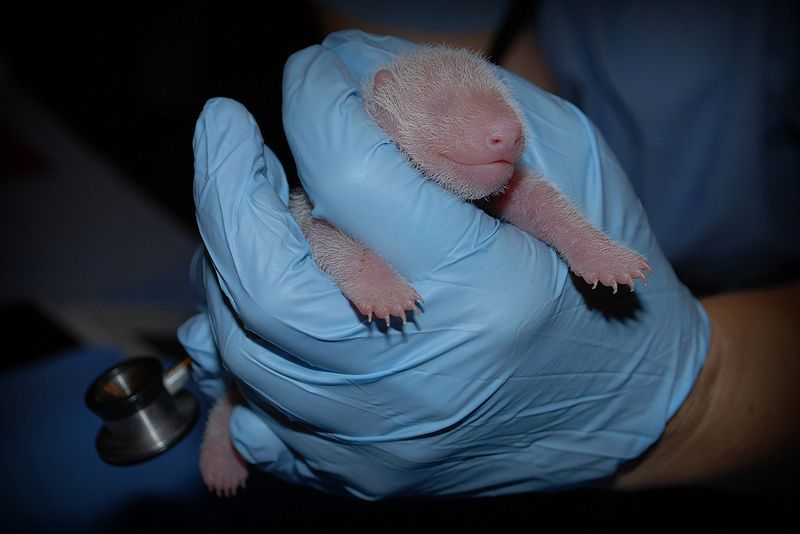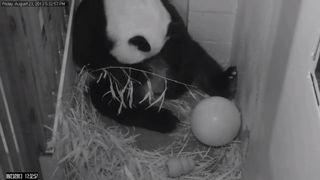Newborn National Zoo Panda Cub Is Healthy, Had a Stillborn Twin

The giant panda cub born Friday (Aug. 23) at the Smithsonian's National Zoo in Washington, D.C., received its first checkup and appears to be healthy, zoo workers said. But keepers also discovered over the weekend that the cub had a stillborn twin.
The live newborn, which weighed about 4.8 ounces (137 grams), had a steady heartbeat and seemed to be breathing, nursing and digesting normally, the zoo said after the cub's first exam on Sunday (Aug. 25).
"All signs are that we have a very healthy, active, vibrant cub," zoo officials said. [In Photos: Giant Panda Mei Xiang Gives Birth]
The cub's mom, Mei Xiang (may-SHONG), gave birth to a second cub on Saturday (Aug. 24) at 7:29 pm ET, but it was stillborn. Zoo staff said the baby was never alive and did not appear fully formed. Mei groomed the cub for about 17 minutes, but then it fell from its mother's body and lay motionless on the den floor, where keepers picked it up with a grabbing device.
Zoo staff said they would not be able to determine the live cub's sex for two or three weeks. A paternity test will also reveal the identity of its father.
Mei Xiang was artificially inseminated twice when she went into estrus back in March. The first insemination contained a mixture of fresh and frozen semen from the National Zoo's adult male, Tian Tian. A second insemination was made up of frozen semen from Tian Tian and frozen semen collected from Gao Gao, of the San Diego Zoo, in 2003.

Mei Xiang gave birth to her first cub, named Tai Shan, in 2005. Tai Shan now lives at the Bifengxia Panda Base in Ya'an, China. (All pandas officially belong to China under international law.) Mei Xiang's second cub was born on Sept. 16, 2012, but died six days later from liver damage due to underdeveloped lungs, zookeepers said.
Sign up for the Live Science daily newsletter now
Get the world’s most fascinating discoveries delivered straight to your inbox.
Conservationists estimate that there are just 1,600 pandas left in the wild — in mountainous, often fragmented, forest habitats in China. Captive breeding is one way to boost the species' population numbers and genetic diversity, but it is notoriously tricky.
Female giant pandas are only fertile for a few days each year. Even if they do get pregnant during that short window, zookeepers often don't know it until a cub materializes. That's because female giant pandas sometimes undergo a "pseudopregnancy" that mimics the real thing with a rise in hormone levels and nesting behavior.
An ultrasound is the only definitive way to find out if a female panda is pregnant before she gives birth, according to the National Zoo. Veterinarians had not seen any evidence of a fetus during Mei Xiang's last ultrasound on Aug. 5. Marsupials aside, giant panda babies are the smallest newborns relative to their mothers among mammals, typically weighing about one-thousandth of their mother's weight, and fetuses don't begin developing until the last few weeks of gestation.
Mei Xiang's new cub is the third born in the United States this year. The other two, twins, were born to Zoo Atlanta's female panda Lun Lun on July 15.
Elsewhere, panda keepers remain on watch for cubs. The Edinburgh Zoo's female Tian Tian was inseminated in April and recently has been showing an encouraging rise in progesterone, a hormone that increases during pregnancy. But her keepers cautioned that this does not mean a cub is guaranteed.
"If indeed she is pregnant, this is an extremely risky time for panda pregnancies," the Scottish zoo said in a statement today (Aug. 26). "Female giant pandas can actually reabsorb any [fetuses] or reject them if pregnant. If she is pregnant and carries to full term, we believe a cub or cubs could be born anytime over the next two weeks — although there are no certainties we must err on the side of caution and be on red alert from today."
Follow Megan Gannon on Twitter and Google+. Follow us @livescience, Facebook & Google+. Original article on LiveScience.











